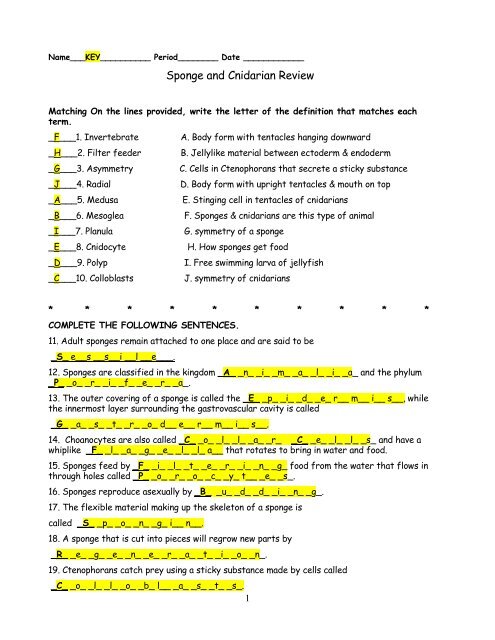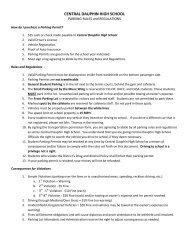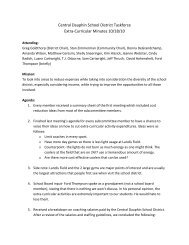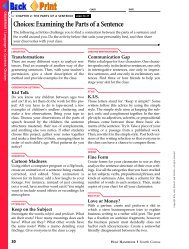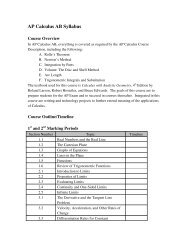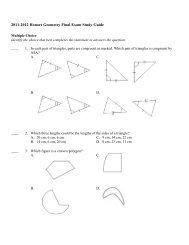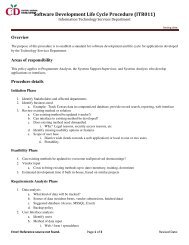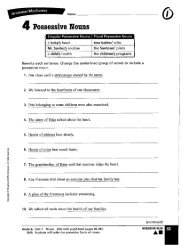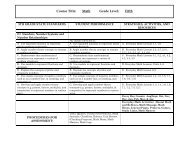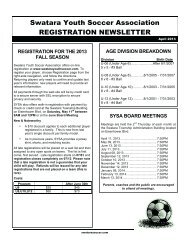Sponge and Cnidarian Review
Sponge and Cnidarian Review
Sponge and Cnidarian Review
Create successful ePaper yourself
Turn your PDF publications into a flip-book with our unique Google optimized e-Paper software.
Name___KEY__________ Period________ Date ____________<br />
<strong>Sponge</strong> <strong>and</strong> <strong>Cnidarian</strong> <strong>Review</strong><br />
Matching On the lines provided, write the letter of the definition that matches each<br />
term.<br />
_F___1. Invertebrate A. Body form with tentacles hanging downward<br />
_H___2. Filter feeder B. Jellylike material between ectoderm & endoderm<br />
_G___3. Asymmetry C. Cells in Ctenophorans that secrete a sticky substance<br />
_J___4. Radial D. Body form with upright tentacles & mouth on top<br />
_A___5. Medusa E. Stinging cell in tentacles of cnidarians<br />
_B___6. Mesoglea F. <strong>Sponge</strong>s & cnidarians are this type of animal<br />
_I___7. Planula G. symmetry of a sponge<br />
_E___8. Cnidocyte H. How sponges get food<br />
_D___9. Polyp I. Free swimming larva of jellyfish<br />
_C___10. Colloblasts J. symmetry of cnidarians<br />
* * * * * * * * * *<br />
COMPLETE THE FOLLOWING SENTENCES.<br />
11. Adult sponges remain attached to one place <strong>and</strong> are said to be<br />
_S_ e__s __s__i __l __e___.<br />
12. <strong>Sponge</strong>s are classified in the kingdom _A_ _n_ _i_ _m_ _a_ _l_ _i_ _a_ <strong>and</strong> the phylum<br />
_P_ _o_ _r_ _i_ _f_ _e_ _r_ _a_.<br />
13. The outer covering of a sponge is called the _E_ _p_ _i_ _d_ _e_ r__ m__ i__ s__, while<br />
the innermost layer surrounding the gastrovascular cavity is called<br />
_G_ _a_ _s_ _t_ _r_ _o_ d__ e__ r__ m__ i__ s__.<br />
14. Choanocytes are also called _C_ _o_ _l_ _l_ _a_ _r_ _C_ _e_ _l_ _l_ _s_ <strong>and</strong> have a<br />
whiplike _F_ _l_ _a_ _g_ _e_ _l_ _l_ a__ that rotates to bring in water <strong>and</strong> food.<br />
15. <strong>Sponge</strong>s feed by _F_ _i_ _l_ _t_ _e_ _r_ _i_ _n_ _g_ food from the water that flows in<br />
through holes called _P_ _o_ _r_ _o_ _c_ _y_ t__ _e_ _s_.<br />
16. <strong>Sponge</strong>s reproduce asexually by _B_ _u_ _d_ _d_ _i_ _n_ _g_.<br />
17. The flexible material making up the skeleton of a sponge is<br />
called _S_ _p_ _o_ _n_ _g_ i__ n__.<br />
18. A sponge that is cut into pieces will regrow new parts by<br />
_R_ _e_ _g_ _e_ _n_ _e_ _r_ _a_ _t_ _i_ _o_ _n_.<br />
19. Ctenophorans catch prey using a sticky substance made by cells called<br />
_C_ _o_ _l_ _l_ _o_ _b_ l__ _a_ _s_ _t_ _s_.<br />
1
20. _B_ _i_ _o_ _l_ _u_ _m_ _i_ _n_ _e_ _s_ c__ _e_ _n_ _c_ _e_ is a feature in which<br />
comb jellies produce light by a chemical reaction.<br />
21. Box jellies are in the class _C_ _u_ _b_ _o_ _z_ _o_ _a_.<br />
22. The dominant body form of the jellyfish is the _M_ _e_ _d_ _u_ _s_ _a_, but it goes<br />
through a larval stage called the _P_ _l_ _a_ n__ _u_ _l_ _a_ that swims by using its<br />
_C_ _i_ _l_ _i__ _a_.<br />
23. The class of cnidarians referred to as the "flower animals" are the<br />
_A_ _n_ _t_ h__ _o_ _z_ _o_ a__ <strong>and</strong> contains the _S_ e__ a__<br />
_A_ n__ _e_ _n_ _o_ _m_ _e_ <strong>and</strong> _C_ _o_ _r_ _a_ _l_.<br />
24. Limestone cases of some cnidarians build up <strong>and</strong> form underwater _C_ _o_ _r_ _a_ _l_<br />
_R_ _e_ _e_ _f_ _s_.<br />
25. Box jellies have a _C_ _u_ _b_ _e_ shaped _M_ _e_ _d_ _u_ _s_ _a_.<br />
26. The _C_ _l_ _o_ _w_ _n_ _f_ _i_ s__ _h_ lives<br />
_S_ _y_ m__ _b_ _i_ _o_ _t_ _i_ _c_ _a_ _l_ l__ _y_ in the tentacles of sea anemones.<br />
27. Corals live as _P_ _o_ _l_ _y_ _p_ _s_ in _C_ _o_ _l_ _o_ _n_ _i_ e__ _s_ within<br />
their limestone skeletons.<br />
28. Jellyfish are in the class of cnidarians called _S_ _c_ _y_ _p_ _h_ _o_ z__ o__ _a_.<br />
29. _P_ _o_ _r_ _t_ _u_ _g_ u__ e__ s__ e__ _M_ _a_ _n_ - _o_ _f_ - _W_ a__ r__<br />
exists as _C_ _o_ _l_ _o_ _n_ i__ e__ _s_ of both polyps <strong>and</strong> medusae in marine habitats.<br />
30. Hydra are freshwater _C_ _n_ _i_ _d_ _a_ _r_ _i_ _a_ _n_ _s_ that can produce both<br />
sperm <strong>and</strong> eggs.<br />
31. Stinging cells in cnidarians are located in their _T_ _e_ _n_ t__ _a_ _c_ _l_ _e_ _s_.<br />
32. <strong>Cnidarian</strong>s have a _N_ _e_ _r_ _v_ _e_ _N_ e__ _t_ to transmit responses to various<br />
parts of the body.<br />
33. The harpoon-shaped structure in the cnidarian stinging cells is known as the<br />
_N_ _e_ m__ a__ _t_ _o_ _c_ _y_ _s_ _t_.<br />
34. Unlike sponges that are organized only into<br />
_S_ _p_ _e_ _c_ _i_ _a_ _l_ _i_ z__ e__ d__ _C_ _e_ _l_ _l_ _s_, cnidarians have the<br />
_T_ _i _s_ _s_ _u_ _e_ level of organization also.<br />
35. Stinging cells contain a poison used to _P_ _a_ _r_ a_ _l_ _y_ _z_ _e_ their prey.<br />
36. _A_ _m_ _e_ _b_ _o_ _c_ _y_ t__ e__ s__ are cells in sponges that move about <strong>and</strong><br />
deliver _N_ _u_ _t_ _r_ _i_ _e_ _n_ _t_ _s_ to other cells within the sponge.<br />
Label the external structures of the sponge.<br />
bud<br />
2<br />
Osculum<br />
Incurrent pores<br />
or Porocytes
Label the parts of the choanocyte or collar cell.<br />
What is the function of this specialized cell? To catch food by circulating<br />
water<br />
In what type of animal can this cell be found? <strong>Sponge</strong>s<br />
These cells are found lining what layer of the animal? Gastrodermis<br />
(Gastrovascular cavity)<br />
What other specialized cells do these cells work with in the animal? amebocytes<br />
* * * * * * * * * *<br />
COMPLETE THE FOLLOWING TABLE FOR SPONGES.<br />
Sessile or<br />
Motile?<br />
Sessile<br />
Cells that<br />
Obtain<br />
Food?<br />
Choanocytes<br />
(collar cells)<br />
Asexual<br />
method of<br />
Reproduction?<br />
budding<br />
Cells that<br />
Distribute<br />
Food?<br />
Nucleus Collar Flagellum<br />
Internal<br />
Buds?<br />
Yes<br />
(gemmules)<br />
Opening<br />
where<br />
Water<br />
leaves?<br />
3<br />
Regrowing<br />
missing<br />
parts?<br />
Yes<br />
Opening<br />
(cells)<br />
Where<br />
Water<br />
Enters?<br />
Amebocytes Osculum Porocytes<br />
Hermaphrodites<br />
or Separate<br />
Sexes?<br />
Some separate;<br />
Hermaphrodite<br />
Rotates to<br />
Bring in water?<br />
Flagella<br />
creates water<br />
movement<br />
Type of<br />
Feeder?<br />
Filter<br />
Phylum?<br />
Porifera
* * * * * * * * * *<br />
TRUE OR FALSE. Write + if the sentence is correct or write O if it is incorrect.<br />
If the statement is false, change the statement to a correct one.<br />
____F - no______ 1. <strong>Sponge</strong>s have tissues <strong>and</strong> organs.<br />
__F – internal____ 2. Gemmules are external buds made by sponges to reproduce.<br />
___T___________ 3. Amebocytes move around <strong>and</strong> distribute food in sponges.<br />
_F - porocytes___ 4. Water enters a sponge through its osculum.<br />
__F - not_______ 5. <strong>Cnidarian</strong>s are filter feeders.<br />
___T___________ 6. Pores in sponges are called Ostia or porocytes.<br />
___T___________ 7. Members of the class Anthozoa build up <strong>and</strong> form reefs.<br />
___T___________ 8. Spicules help make up the skeleton of sponges.<br />
__F - gastrodermis 9. The epidermis lines the gastrovascular cavity of cnidarians.<br />
_T_____________ 10. Both hydra <strong>and</strong> sponges reproduce asexually by budding.<br />
_T_____________ 11. The phylum Scyphozoa sting <strong>and</strong> paralyze their prey.<br />
_F – jellylike_____ 12. Mesoglea is a cellular layer in both sponges <strong>and</strong> cnidarians.<br />
__T____________ 13. Both choanocytes <strong>and</strong> amebocytes help get food for sponges.<br />
_F- only polyps__ 14. Anthozoans live their lives as both polyps <strong>and</strong> medusae.<br />
F – polyp or bottom15. Medusa form cnidarians have their mouth located on the top.<br />
_F – st<strong>and</strong> upward 16. Polyps have tentacles that hang downward.<br />
_F - Ctenophora__ 17. Box jellies produce their own light by bioluminescence.<br />
* * * * * * * * * *<br />
Complete the following table for cnidarians.<br />
Classes of<br />
<strong>Cnidarian</strong>s<br />
Scyphozoa<br />
Hydrozoa<br />
Anthozoa<br />
MEMBERS SYMMETRY BODY<br />
FORM(S)<br />
Jellyfish Radial<br />
Hydras<br />
Port.-man<br />
of War<br />
Sea anemones<br />
Corals<br />
Radial<br />
4<br />
Polyps –<br />
young<br />
Medusa -<br />
adult<br />
Polyp<br />
Colony of<br />
polyp &<br />
medusa<br />
UNIQUE<br />
CHARACTERISTIC(S)<br />
Resemble upside down<br />
“cups”<br />
bell-shaped<br />
Can be found in<br />
freshwater<br />
Radial Polyps Resemble “flowers”
* * * * * * * * * *<br />
Label the parts of the cnidarian <strong>and</strong> tell which is polyp form <strong>and</strong> which is medusa form.<br />
tentacles<br />
mouth<br />
gastrovascular<br />
cavity<br />
5<br />
mesoglea<br />
* * * * * * * * * *<br />
MUTIPLE CHOICE. Circle the correct letter or letters.<br />
Spongin <strong>and</strong> spicules are important to sponges because<br />
A. They digest food<br />
B. They remove wastes<br />
C. They provide support<br />
D. They reproduce offspring<br />
Which of the following is NOT found in cnidarians?<br />
A. Tentacles<br />
B. Choanocytes<br />
C. Nematocysts<br />
D. Gastrovascular cavity<br />
<strong>Sponge</strong> : osculum :: hydra :<br />
A. Mouth<br />
B. Tentacle<br />
C. Nerve Net<br />
D. Nematocyst<br />
Gastrovascular<br />
cavity<br />
mouth<br />
tentacles
The function of colloblasts is<br />
A. To produce light<br />
B. To secrete a sticky substance<br />
C. To draw in water<br />
D. To form medusae that live in colonies<br />
The structure in Ctenophorans that orients them in the water is<br />
A. Colloblast<br />
B. Tentacles<br />
C. Apical organ<br />
D. Comb<br />
Jellyfish are in the class<br />
A. Cnidaria<br />
B. Hydrozoa<br />
C. Anthozoa<br />
D. Scyphozoa<br />
The defensive structures in cnidarians are<br />
A. Colloblasts<br />
B. Cnidocytes<br />
C. Choanocytes<br />
D. Amoebocytes<br />
Sensory cells that help a cnidarian determine the direction of gravity are<br />
A. Nerve nets<br />
B. Statocysts<br />
C. Nematocysts<br />
D. Spicules<br />
What allows cnidarian polyps to exp<strong>and</strong>, shrink, <strong>and</strong> move their tentacles?<br />
A. Hydrostatic skeleton<br />
B. Choanocytes<br />
C. Cnidocytes<br />
D. Apical organ<br />
6


